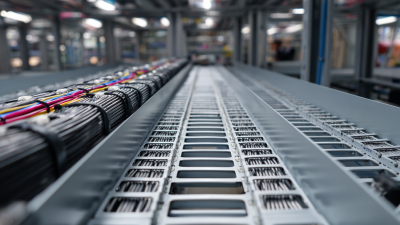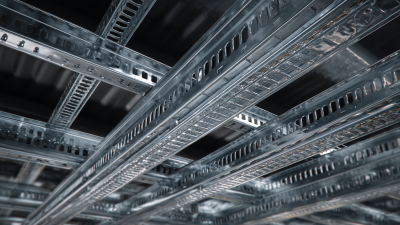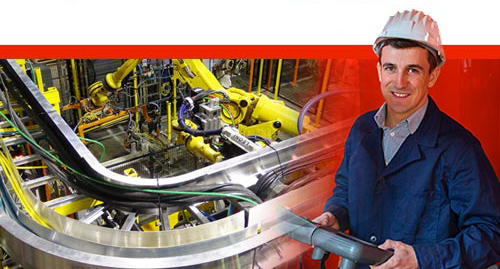For over 50 years, we have dedicated ourselves to providing Industry with best in class wire management solutions and to helping solve mission critical issues.
The needs of today’s schools and universities are changing fast. When it comes to anticipating and meeting those needs, MonoSystems is in a class of its own.
For the past five decades, we’ve made it our business to offer more value to our partners, which in turn provides greater value to their customers.
2025's Top 10 Basket Cable Tray Solutions for Efficient Cable Management
In an era where efficient cable management has become synonymous with operational excellence, the popularity of basket cable trays is on the rise. According to a recent report by the Global Cable Management Systems Market Analysis, the demand for cable management solutions, including basket cable trays, is projected to grow by 12% annually through 2025. This increase is attributed to the rapid expansion of infrastructure projects and the growing emphasis on sustainable building practices.
Industry expert John Smith, a leading consultant in cable management systems, emphasizes the importance of innovation in this field, stating, "Adopting the right basket cable tray solutions not only minimizes installation time and costs but also enhances the safety and efficiency of cable distribution." With numerous products flooding the market, identifying the top solutions that combine durability, flexibility, and cost-effectiveness is crucial for businesses aiming to optimize their cable management strategies.
As we explore the top 10 basket cable tray solutions for 2025, our focus will be on not just the features and benefits of these systems but also their integral role in ensuring a streamlined and efficient environment for electrical infrastructure.

The Importance of Cable Tray Systems in Modern Infrastructure Projects
In today's modern infrastructure projects, the importance of cable tray systems cannot be overstated. These systems play a critical role in the organization and management of cables, ensuring that electrical wiring is neatly routed and secured. This not only enhances the safety of installations by reducing the risk of accidents caused by tangled wires but also simplifies maintenance and inspections. With an increasing reliance on technology and electricity, effective cable management solutions are paramount.
As infrastructure evolves, the need for efficient cable management solutions becomes even more pressing. Basket cable trays, in particular, offer a versatile and cost-effective way to support various types of cabling while maintaining proper airflow. Their open design allows for easy installation and modification, accommodating changes in technology and infrastructure without the need for extensive rewiring. By integrating advanced cable tray systems in the planning stages of projects, engineers and designers can create more efficient, reliable, and sustainable environments that meet the demands of modern society.
Key Features to Look for in High-Quality Basket Cable Tray Solutions
When selecting a high-quality basket cable tray solution for efficient cable management, there are several key features to consider. First, ensure that the tray is constructed from durable materials that can withstand environmental factors. Galvanized steel or aluminum are often preferred for their strength and resistance to corrosion. Additionally, look for trays that offer adjustable sizes to accommodate various cable capacities and allow for easy reconfiguration as needs evolve.
Another critical aspect is the design of the tray. Opt for options that promote ventilation to prevent overheating of cables, especially in high-traffic areas. A basket design not only facilitates airflow but also allows for easy access during maintenance. Furthermore, compatibility with additional accessories, such as cable clamps and mounting brackets, can enhance the functionality of the cable management system.
Tips for effective cable management include organizing cables with labels to identify connections easily and using cable ties or clips to secure and tidy loose wires. Regularly inspecting the arrangement helps to prevent tangles and ensures that the system operates efficiently. By focusing on these features, businesses can improve their cable management strategies, paving the way for a more streamlined and productive work environment.
Comparative Analysis of Materials Used in Basket Cable Trays: Steel vs. Aluminum
When selecting materials for basket cable trays, the choice between steel and aluminum is crucial for efficient cable management. Steel, known for its strength and durability, is often preferred in industrial settings where heavy cable loads are common. Its resistance to impact and deformation makes it ideal for environments with high traffic or heavy machinery. However, steel can be prone to corrosion if not properly treated, which is where aluminum comes into play. Lightweight and resistant to corrosion, aluminum is well-suited for installations in humid or outdoor environments, where exposure to moisture can be a significant concern.
Tips: When deciding on the material for your cable trays, consider the specific needs of your installation environment. For heavily trafficked areas, opt for steel to ensure longevity. If your project is in a location prone to moisture, aluminum might be the better choice to prevent corrosion.
Additionally, consider the overall weight and installation process. Aluminum’s lightweight nature can reduce labor costs and installation time, making it an attractive option for many projects. Balancing these factors will lead to more informed decisions and ultimately enhance the efficiency of your cable management system.
Regulatory Compliance and Safety Standards for Cable Management Solutions
In the rapidly evolving field of cable management, regulatory compliance and safety standards play a crucial role in ensuring the effectiveness and reliability of basket cable tray solutions. As modern infrastructures become increasingly dependent on sophisticated electrical systems, adherence to established codes and regulations becomes imperative. Agencies such as the National Electrical Code (NEC) and International Electrotechnical Commission (IEC) establish guidelines for the installation and maintenance of cable trays, ensuring that they can safely support various cable types while minimizing fire risks and electrical hazards.

Moreover, safety standards extend beyond mere compliance; they encompass aspects such as load-bearing capacity, material durability, and environmental resistance. For instance, using non-corrosive materials is vital in industries exposed to harsh conditions, thus enhancing the longevity of cable trays. Additionally, integrating features like proper grounding and bonding ensures that installations meet safety and performance standards. Companies that prioritize these regulations not only safeguard their operations but also foster trust among clients and stakeholders by showcasing their commitment to safety and efficiency in cable management.
Cost-Benefit Analysis: Investing in Quality Cable Trays for Long-Term Efficiency
Investing in quality cable trays is paramount for ensuring long-term efficiency and cost-effectiveness in cable management systems. According to a report by the National Electrical Contractors Association (NECA), effective cable management can lead to a 30% reduction in installation time. This significant time saving translates into lower labor costs and increased project turnover, making it a financially viable option for businesses looking to optimize their operational expenditures.

Moreover, a study published by the International Society of Automation (ISA) emphasizes that the durability and design of cable trays significantly influence maintenance costs. High-quality materials can extend the lifespan of cable trays by up to 50%, reducing the frequency of replacements and maintenance. For enterprises managing extensive wiring setups, this longevity results in considerable savings, as they avoid the disruption and expense associated with routine cable tray replacements. The cost-benefit analysis clearly indicates that while the initial investment in superior cable trays may be higher, the long-term savings and efficiency gains provide a compelling reason for companies to prioritize quality over cost alone.
Related Posts
-

Ultimate Guide to Electrical Cable Trays: Optimizing Efficiency and Safety in Modern Installations
-

Mastering the Best Cable Tray Desk for Ultimate Workspace Organization
-

Exploring Cable Tray Wire Innovations at the 138th China Import and Export Fair in 2025
-

Ultimate Checklist for Choosing the Best Metal Cable Tray for Your Project Needs
-

Understanding Import and Export Certifications for the Best Stainless Steel Cable Tray
-

The Future of Ladder Cable Tray Innovation in Electrical Infrastructure


